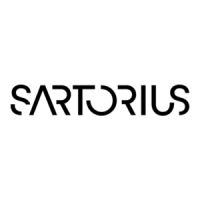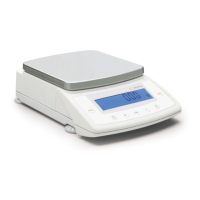Do you have a question about the Sartorius CPA2202S and is the answer not in the manual?
General safety guidelines for using the balance and preventing damage.
Specific safety measures related to balance installation and power connection.
Guidelines for proper storage and transport to maintain balance integrity.
Steps for safely unpacking the equipment and checking for damage.
Criteria for selecting a suitable location for balance installation.
Procedure to acclimate the balance to ambient temperature before use.
Information about the seal on balances verified for legal metrology in the EU.
Instructions for assembling components for the CPA2P model.
Steps for installing components for the CPA2P-F model, including filter pans.
Guidance on positioning and securing the analytical draft shield.
Procedure for connecting specific balance models to their electronics box.
Steps for mounting the balance with a 3-sided draft shield.
Instructions for setting up balances with rectangular weighing pans up to 10 kg.
Instructions for setting up balances with rectangular weighing pans over 10 kg.
Steps for connecting the balance to the AC power supply using the adapter.
Information on using country-specific power cords with the AC adapter.
Recommended time for the balance to warm up for accurate results.
How to secure the balance using an antitheft locking device.
Procedure for leveling balances with a weighing capacity up to 10 kg.
Procedure for leveling balances with a weighing capacity over 10 kg.
Identification and description of the balance's display elements and operating keys.
Requirements for using balances as legal measuring instruments in the EU.
Tips for operating microbalances, emphasizing steady hand and technique.
Instructions for setting up below-balance weighing for analytical balances and microbalances.
Explanation of calibration and adjustment purposes and general features.
Requirements for internal calibration for legal measuring instruments.
Information on external calibration for balances of accuracy class II.
Step-by-step process for internal calibration and adjustment.
How to configure whether calibration is followed by auto-adjustment.
Explanation of the automatic calibration function and its activation.
Detailed steps for performing internal calibration, including display outputs.
Detailed steps for performing external calibration, including display outputs.
Instructions on how to print current balance parameter settings.
Steps to enter and navigate the balance's setup menu.
Guide to configuring balance settings using menu codes for different ambient conditions.
Explanation of key operations for setting IDs, time, date, and display brightness.
Description of function keys (F, CF) used for navigating application programs.
Details on using the Net-total Formulation program to weigh components.
Description of function keys (F, CF) for the Counting program.
How to set and store the reference sample quantity for counting.
Automatic updating of reference sample quantity to optimize counting accuracy.
Using a reference balance for higher precision in counting large amounts of parts.
Steps to set parameters for the Counting program.
Description of function keys (F, CF) for the Weighing in Percent program.
How to set and store the reference percentage for weighing calculations.
Description of function keys (F, CF) for the Animal Weighing program.
How to set the number of subweighing operations for averaging.
Steps to configure the "Toggle Weight Units" application in the setup menu.
Options for generating automatic or manual printouts and customizing line format.
How to generate printouts compliant with ISO/GLP standards including ambient data.
Menu codes to configure ISO/GLP compliant records and line formats.
Using function keys to output headers, reference data, and close applications.
Details on connecting the balance to computers via the serial interface and its parameters.
How non-verified digits are identified on printouts using specific settings.
Explanation of the 16-character data output format, including special and error codes.
Explanation of the 22-character data output format, including ID codes and units.
Defines formats for sending control commands to the balance from a computer.
Detailed pin assignments for the female and male interface connectors.
Visual representation of the cabling for connecting a computer to the balance.
Steps to prepare the CPA2P model for transport, including removing parts.
Steps to prepare the CPA2P-F model for transport, including filter pan removal.
Guidelines for cleaning the balance, including stainless steel surfaces and weighing chambers.
Procedures for safety inspection and recommended periodic checks of the power supply.
Information on proper disposal of equipment, batteries, and packaging according to EU regulations.
Overview of directives and regulations for weighing instruments used in legal metrology.
Information regarding the EC Type-Approval Certificate for weighing instruments.
Details of the type conformity declaration related to EU directive 90/384/EEC.
General safety guidelines for using the balance and preventing damage.
Specific safety measures related to balance installation and power connection.
Guidelines for proper storage and transport to maintain balance integrity.
Steps for safely unpacking the equipment and checking for damage.
Criteria for selecting a suitable location for balance installation.
Procedure to acclimate the balance to ambient temperature before use.
Information about the seal on balances verified for legal metrology in the EU.
Instructions for assembling components for the CPA2P model.
Steps for installing components for the CPA2P-F model, including filter pans.
Guidance on positioning and securing the analytical draft shield.
Procedure for connecting specific balance models to their electronics box.
Steps for mounting the balance with a 3-sided draft shield.
Instructions for setting up balances with rectangular weighing pans up to 10 kg.
Instructions for setting up balances with rectangular weighing pans over 10 kg.
Steps for connecting the balance to the AC power supply using the adapter.
Information on using country-specific power cords with the AC adapter.
Recommended time for the balance to warm up for accurate results.
How to secure the balance using an antitheft locking device.
Procedure for leveling balances with a weighing capacity up to 10 kg.
Procedure for leveling balances with a weighing capacity over 10 kg.
Identification and description of the balance's display elements and operating keys.
Requirements for using balances as legal measuring instruments in the EU.
Tips for operating microbalances, emphasizing steady hand and technique.
Instructions for setting up below-balance weighing for analytical balances and microbalances.
Explanation of calibration and adjustment purposes and general features.
Requirements for internal calibration for legal measuring instruments.
Information on external calibration for balances of accuracy class II.
Step-by-step process for internal calibration and adjustment.
How to configure whether calibration is followed by auto-adjustment.
Explanation of the automatic calibration function and its activation.
Detailed steps for performing internal calibration, including display outputs.
Detailed steps for performing external calibration, including display outputs.
Instructions on how to print current balance parameter settings.
Steps to enter and navigate the balance's setup menu.
Guide to configuring balance settings using menu codes for different ambient conditions.
Explanation of key operations for setting IDs, time, date, and display brightness.
Description of function keys (F, CF) used for navigating application programs.
Details on using the Net-total Formulation program to weigh components.
Description of function keys (F, CF) for the Counting program.
How to set and store the reference sample quantity for counting.
Automatic updating of reference sample quantity to optimize counting accuracy.
Using a reference balance for higher precision in counting large amounts of parts.
Steps to set parameters for the Counting program.
Description of function keys (F, CF) for the Weighing in Percent program.
How to set and store the reference percentage for weighing calculations.
Description of function keys (F, CF) for the Animal Weighing program.
How to set the number of subweighing operations for averaging.
Steps to configure the "Toggle Weight Units" application in the setup menu.
Options for generating automatic or manual printouts and customizing line format.
How to generate printouts compliant with ISO/GLP standards including ambient data.
Menu codes to configure ISO/GLP compliant records and line formats.
Using function keys to output headers, reference data, and close applications.
Details on connecting the balance to computers via the serial interface and its parameters.
How non-verified digits are identified on printouts using specific settings.
Explanation of the 16-character data output format, including special and error codes.
Explanation of the 22-character data output format, including ID codes and units.
Defines formats for sending control commands to the balance from a computer.
Detailed pin assignments for the female and male interface connectors.
Visual representation of the cabling for connecting a computer to the balance.
Steps to prepare the CPA2P model for transport, including removing parts.
Steps to prepare the CPA2P-F model for transport, including filter pan removal.
Guidelines for cleaning the balance, including stainless steel surfaces and weighing chambers.
Procedures for safety inspection and recommended periodic checks of the power supply.
Information on proper disposal of equipment, batteries, and packaging according to EU regulations.
Overview of directives and regulations for weighing instruments used in legal metrology.
Information regarding the EC Type-Approval Certificate for weighing instruments.
Details of the type conformity declaration related to EU directive 90/384/EEC.











